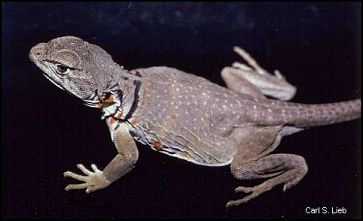
We've all heard that reptiles and amphibians are cold-blooded—but what does this really mean? Certainly not that ice-water flows through their veins. In actuality, it's somewhat of a misnomer. What we really mean is that the body temperature is not under internal control, as it is in birds and mammals, but instead depends on the surrounding conditions.
Body temperature is important because the chemical activity that runs our bodies varies with temperature and that temperature must be relatively high if we're to function efficiently.
Watch some of our Chihuahuan Desert lizards. What's the first thing
they do in the morning? Bask in the sun. It usually doesn't take long to raise
their body temperature high enough for frenetic activity. By shifting between sun and
shade, they can maintain themselves in the active range until the air temperature
climbs too high. Then they retreat into cool burrows or crevices, which they also
utilize during the cool nights. These "cold-blooded" creatures save energy by
turning down the thermostat at night. One might say that they run hot and cold.

Contributor: Arthur H. Harris, Laboratory for Environmental Biology, Centennial Museum, University of Texas at El Paso.
Desert Diary is a joint production of the Centennial Museum and KTEP National Public Radio at the University of Texas at El Paso.

An Eastern Collared Lizard (Crotaphytus collaris), often seen basking on rocks in the early morning hours. Photograph by Carl S. Lieb.
A Question of Cold-bloodedness.